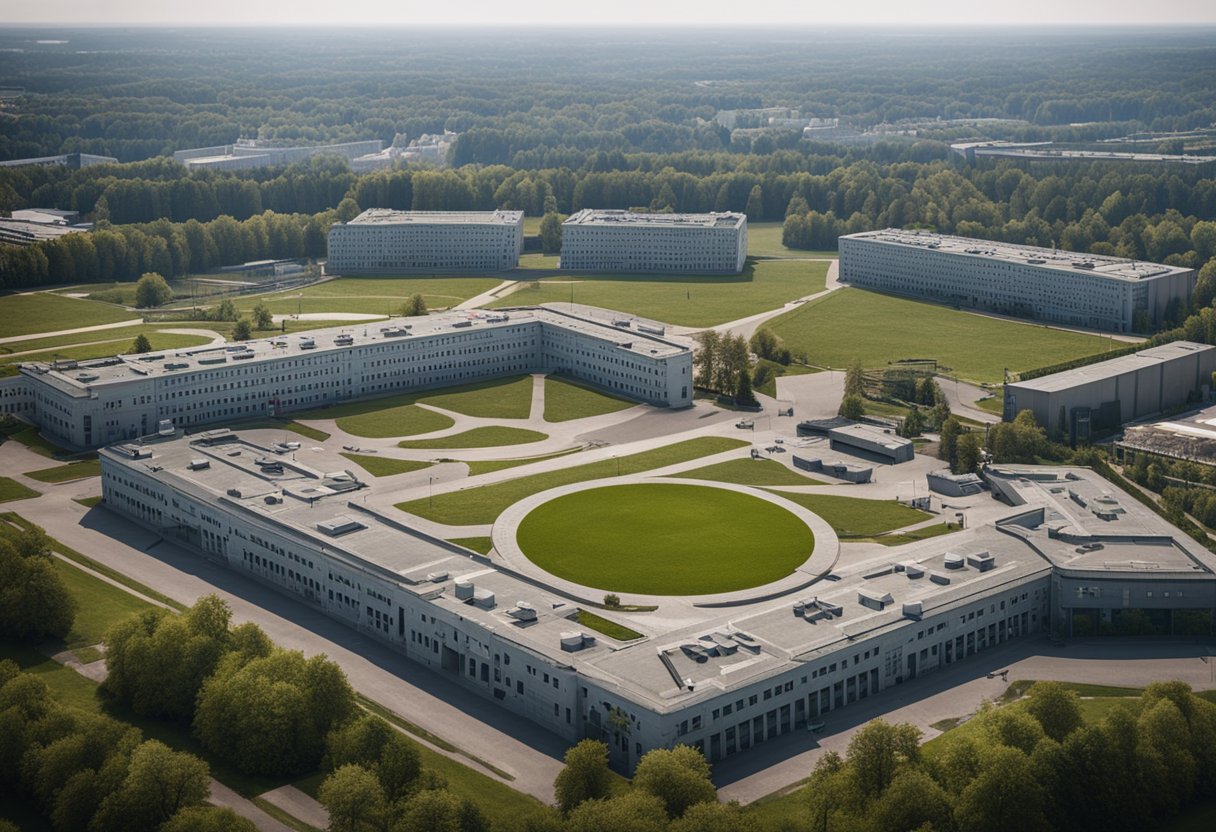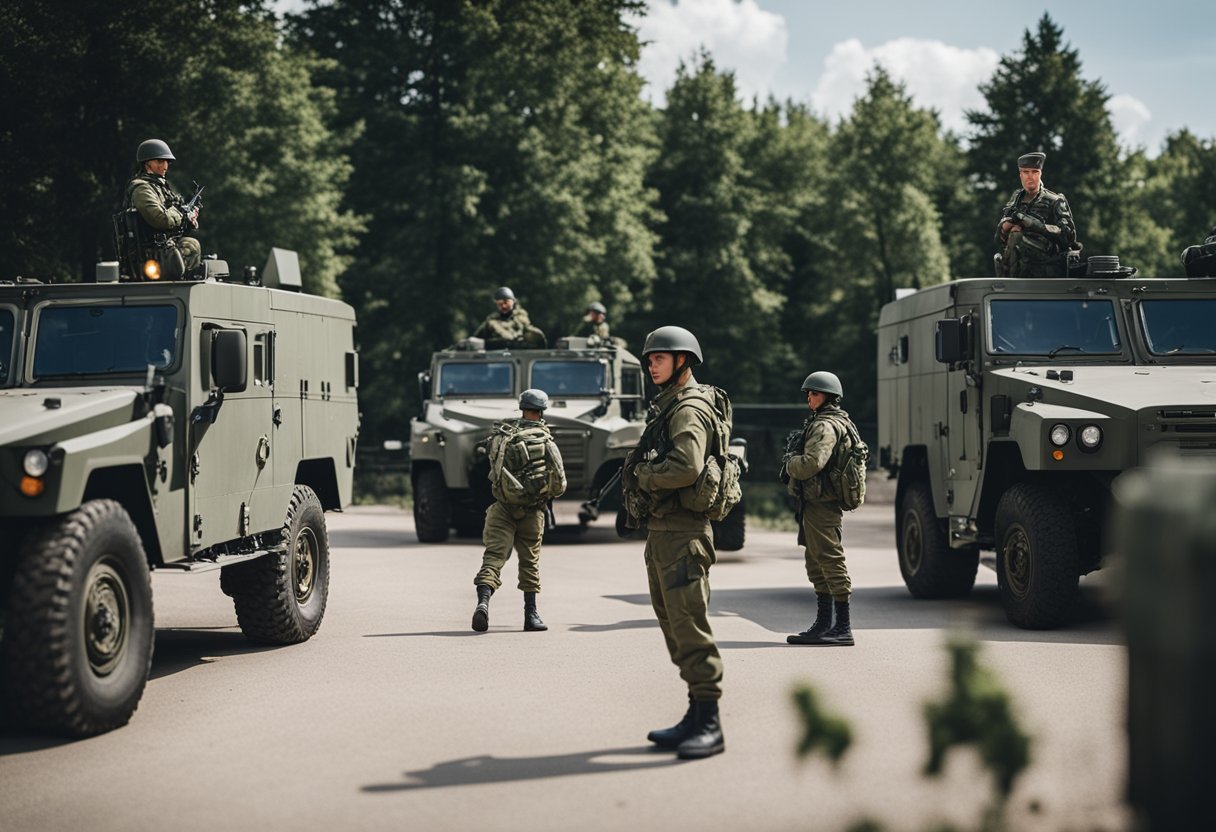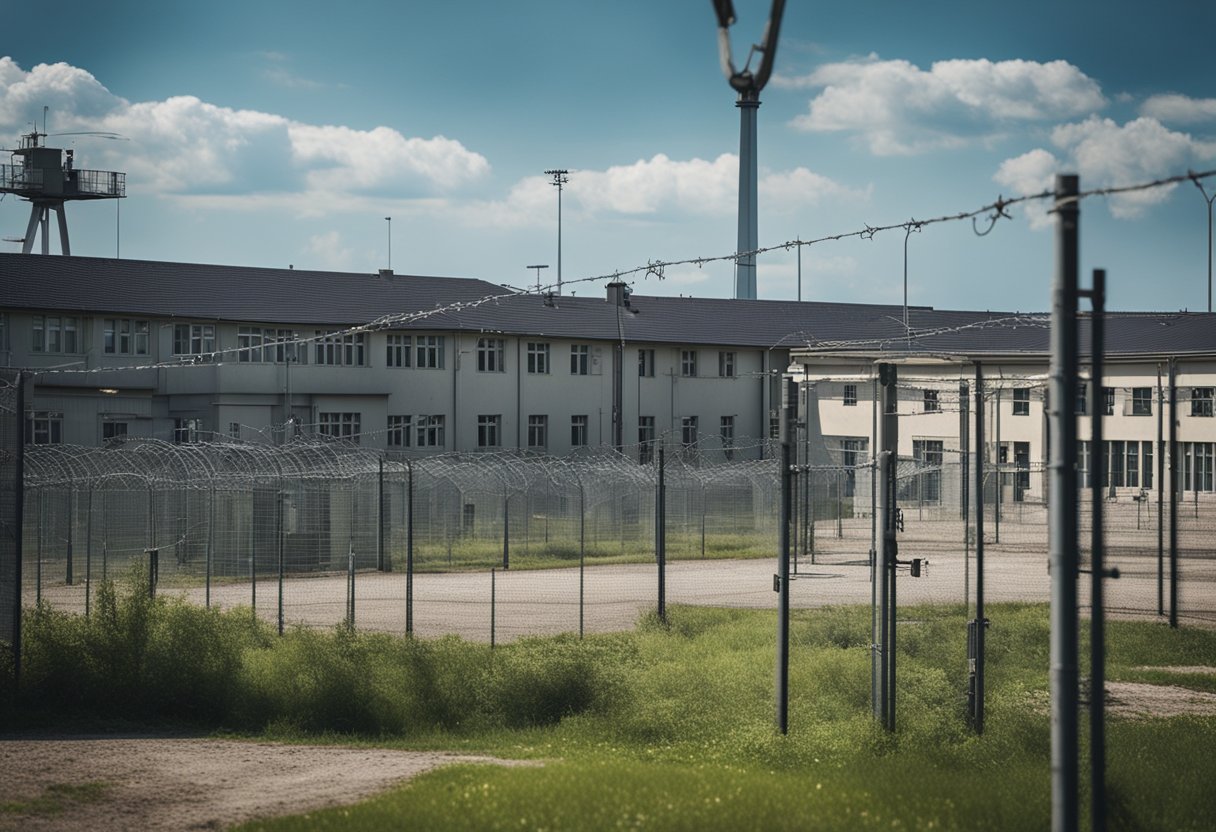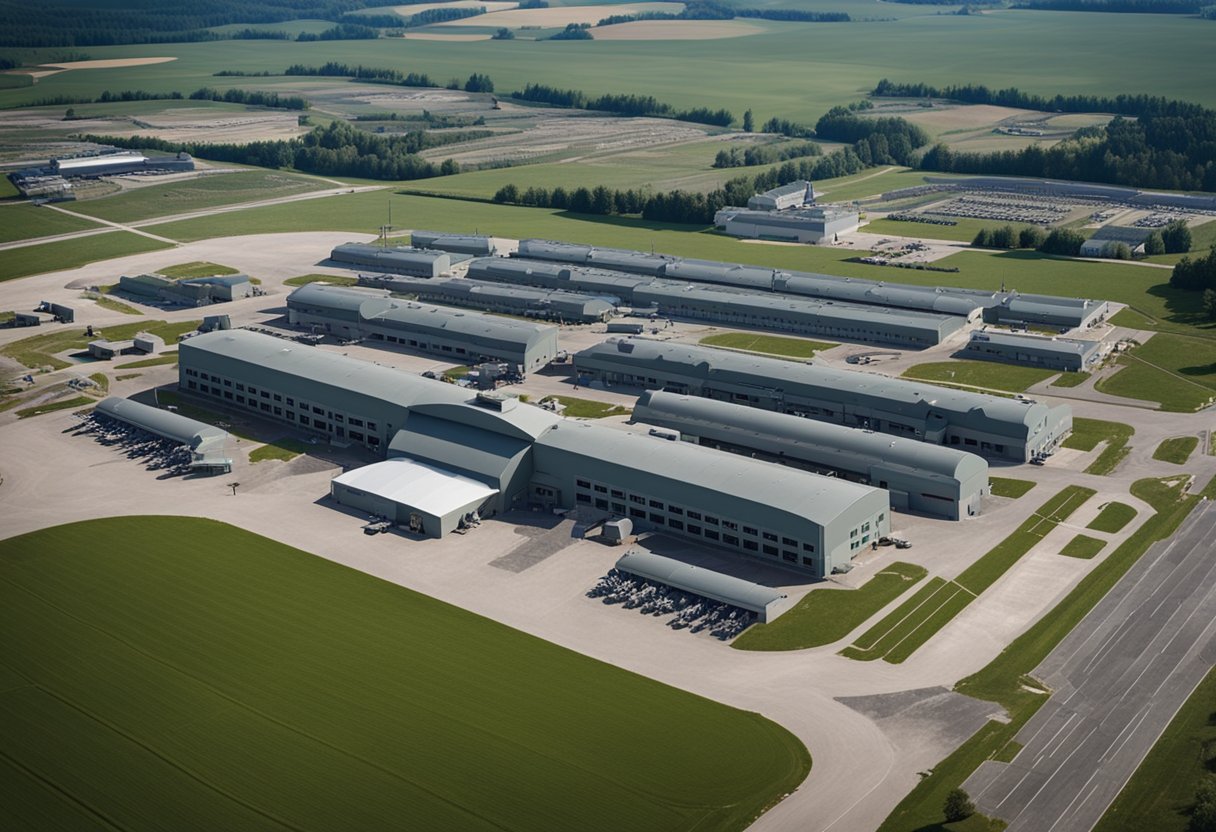Historically, Berlin, Germany has been host to military installations, particularly during the heights of the Cold War when geopolitical tensions made the presence of foreign army base in Berlin, specifically more common in Europe.
The Berlin Brigade was a well-known United States Army unit that symbolized the American commitment to defending West Berlin during this era of confrontation between the East and the West.
Additionally, the city served as a strategic location for the U.S. Army, underpinning the American presence in the divided city of Berlin until the end of the Cold War.

However, in the contemporary period, the landscape of military bases in Germany has changed significantly. Following the reunification of Germany and the easing of tension in Europe, the need for such installations has considerably reduced.
The majority of U.S. military bases are now primarily situated in the southern part of the country rather than in Berlin. The historical installations in Berlin are no more actively serving as U.S. military bases.
In the context of present-day military alignments and the shift in defense strategies, there is no active U.S. Army base within the city limits of Berlin.
This change reflects broader transformations in global military policy, particularly the realignment of U.S. forces in Europe to address contemporary security challenges and the reorganization of NATO’s posture on the continent.
Historical Context of Army Base in Berlin

This section provides an overview of the changing military landscape in Berlin, focusing on the pivotal role of the Cold War, the tensions surrounding the Berlin Wall Crisis, and the eventual closure of military installations following the period of political thaw.
Cold War Era and the Berlin Brigade
During the Cold War, a geopolitical tension between the USSR and the Western bloc, Berlin was a focal point for military rivalry.
The Berlin Brigade was established as a U.S. Army garrison in the city, symbolizing the American commitment to defending West Berlin in the face of Soviet pressures.
Berlin Wall Crisis and U.S. Military Presence
The Berlin Wall Crisis significantly escalated tensions, leading to an increased United States Army presence in the city.
The construction of the Berlin Wall in 1961 physically divided East and West Berlin, and solidified the U.S. military’s resolve to maintain a strong presence through its facilities and personnel, ensuring the security and freedom of West Berlin’s inhabitants.
Closures and Transitions After the Cold War
Following the Cold War’s conclusion and the Berlin Wall’s fall, the strategic necessity for a U.S. military base in Berlin waned.
The subsequent closures of these facilities happened gradually, with the Berlin Brigade being deactivated. This marked the end of a significant chapter in U.S. military history, reflecting the broader geopolitical transitions of the era.
Current Status of Military Installations in Berlin

Berlin, the capital of Germany, does not currently host any active United States military bases within its vicinity.
After the end of the Cold War and the subsequent reunification of Germany, the presence of US military installations in Berlin was reduced, and eventually, all bases were closed or handed back to the German government.
The former US Army installations in Berlin, such as the Berlin Brigade, have a rich history dating back to the end of World War II when Berlin was divided into occupation zones. However, these historical bases, like Tempelhof Airfield and McNair Barracks, are no longer in operation as military facilities.
Today, these sites have been repurposed or incorporated into the urban landscape of Berlin. For example, the Tempelhof Airport has been transformed into a public park known as Tempelhofer Feld, providing ample space for recreational activities for Berlin’s residents.
While Berlin does not have any existing US military installations, Germany still maintains several US bases, particularly in the southern regions of the country. These installations are part of a network of US military presence in Europe but are situated far from Berlin.
In summary, the city of Berlin does not currently have any active army or military bases from the United States, with former installations now repurposed for civilian use or integrated into Berlin’s infrastructure and community.
United States Army Bases in Germany

The United States has maintained a significant military presence in Germany since the end of World War II, with several army bases scattered across the country. These bases play crucial roles in operations, training, and support for both the US Army and its NATO allies.
USAREUR and EUCOM
United States Army Europe (USAREUR) serves as a strategic component of the United States European Command (EUCOM), overseeing a range of military responsibilities and tasks. The headquarters of EUCOM is located in Stuttgart, which facilitates important decision-making for defense strategies across Europe and beyond.
Key Bases and Their Strategic Functions
Among the key installations, Ramstein Air Base in Kaiserslautern stands as a central hub for American airpower in Europe and Africa. It not only supports air operations but also provides rapid response capabilities for a variety of missions. USAG Ansbach, positioned in northern Bavaria, acts as a critical support site, aiding both aviation and ground operations.
Troop Presence and Military Operations
A noteworthy number of troops are stationed across these bases, forming a forward presence that enables the US to respond swiftly to various global challenges. The Wiesbaden area hosts the headquarters for US Army Europe, which plays a pivotal part in coordination and strategic planning of military activities across the continent.
While historical records indicate that the US military had a footprint in Berlin during the Cold War, the current disposition of the United States Army bases in Germany does not include an active base in Berlin.
Impact of Military Bases on Local Communities

In analyzing the footprint of military installations on local German communities, particularly those in regions like Bavaria, it’s crucial to understand the multifaceted impact, including economic, cultural, and environmental aspects.
Economic Influence
Military facilities, such as the US Army Garrison Bavaria which encompasses areas like Hohenfels and Vilseck, have historically been vital economic engines for their respective localities.
Towns like Vilseck demonstrate the significant economic dependency on the U.S. military presence, as a myriad of local businesses thrive on the patronage of service members and their families. Employment opportunities span from direct hires by the military to the ripple effect of job creations in the service and retail sectors catering to the base’s populace.
- Business Boom: Shops, restaurants, and service providers experience heightened business due to the purchasing power of military personnel.
- Job Creation: The military base often emerges as one of the largest employers in the region, offering a mix of civilian and defense-related positions.
Cultural and Social Interactions
US military bases, such as Panzer Kaserne in Böblingen, facilitate a unique blend of American and German cultural exchanges. These interactions are not just limited to the celebrated Oktoberfest, but are evident daily with American service members engaging in local traditions, festivals, and language exchanges.
- Shared Celebrations: Festivals and public events often reveal a deep-seated camaraderie between the military community and local residents.
- Language Learning: English and German language proficiencies are boosted on both sides, fostering better communication and understanding.
Environmental and Infrastructural Considerations
The presence of military installations in areas like Hohenfels has notable environmental and infrastructural repercussions. Regulations often govern the environmental stewardship of these bases to minimize their footprint, and significant investments are typically made in local infrastructure to accommodate military needs, benefiting the local community.
- Environmental Protections: Military bases implement rigorous environmental standards to limit their impact on local ecosystems.
- Infrastructure Upgrades: As military bases expand or modernize, they can contribute to improving local transportation and public services.
Overview of European Theater Operations

The European Theater Operations intricately coordinate defense initiatives involving the United States Armed Forces, and their NATO allies, actively responding to potential conflicts and employing advanced intelligence and surveillance strategies to maintain regional stability.
Coordination with NATO and Allied Forces
With the dissolution of its presence in Berlin, the United States Armed Forces shifted to coordinating with NATO, ensuring a unified response to international security challenges. This involves joint military exercises and strategic planning to bolster the capabilities of allied forces throughout the European Theater.
Responses to Potential Conflicts
Directed responses to potential threats are essential in the European Theater. The United States, in cooperation with NATO and its allies, consistently reviews and updates defense plans. They conduct threat assessments focusing on regions of interest like Russia, readying forces to respond rapidly to any act of aggression.
Intelligence and Surveillance Strategies
Army Intelligence plays a pivotal role in shaping the operational landscape of the European Theater. By leveraging cutting-edge surveillance technology, they provide comprehensive intelligence to NATO, which is critical for maintaining a strategic advantage and informing military decisions.
Installation Facilities and Infrastructure
Army installations in Germany provide numerous facilities to support the personnel stationed there. From living quarters to training facilities, these bases are equipped to ensure readiness and efficiency for the United States Army overseas.
The infrastructure at these installations reflects a commitment to maintaining a robust presence, with some bases like Stuttgart-Vaihingen and Garmisch-Partenkirchen addressing specific strategic needs.
Living Quarters and Amenities
The living quarters at U.S. Army bases, such as those found in Stuttgart-Vaihingen, are designed to provide comfortable accommodations for service members and their families. These installations often include various amenities like shopping centers, schools, and recreational facilities, catering to the needs of a diverse military community.
Training and Readiness
To maintain strategic readiness, bases like the Training Center Griesheim focus on offering state-of-the-art training facilities. These include simulated combat environments and advanced technological equipment which prepare soldiers for a wide range of scenarios. The emphasis is on ensuring that units are combat-ready at all times.
Logistics and Supply Depots
Miesau Army Depot serves as a crucial logistics and supply center supporting U.S. military operations in Europe. It functions as one of the largest ammunition storage sites outside the continental United States, playing a key role in the Army’s supply chain and overall operational capacity.
Technological Capabilities and Equipment
Modern military bases are designed to be centers of advanced technological capabilities and equipment. In this context, let’s examine the specific areas of weaponry, communication systems, and transportation that are integral to military operations.
Weapon Systems and Artillery
Berlin has historically been home to various military installations such as the Artillery Kaserne. Contemporary German Army weapon systems typically encompass a formidable array of hardware, ranging from small arms to sophisticated anti-tank and anti-aircraft weaponry.
The German Army is equipped with advanced artillery systems, such as self-propelled howitzers, which provide critical firepower in support of infantry operations.
Intelligence and Communications Networks
The Dagger Complex, stationed near Darmstadt, exemplifies Germany’s capability in intelligence and communications. It serves as a vital hub for information gathering and distribution.
The German military employs state-of-the-art communications equipment to maintain secure and reliable networks for command and control, intelligence sharing, and logistic support, underpinning their operations with a robust technological foundation.
Mobility and Transportation
Coleman Barracks is known for its role in the logistics and transportation of the U.S. Army in Germany. The logistical aspect of the modern German Army features an array of transportation assets such as armored personnel carriers, utility vehicles, and supply trucks. These vehicles enable rapid deployment and redeployment of troops and equipment, ensuring that infantry units can maneuver effectively across varied terrains.
While there is no standing U.S. Army base in operation in Berlin currently, the persistent advancement in technological capabilities and equipment across German military bases underlines the country’s dedication to maintaining a sophisticated and responsive armed forces.
Healthcare and Military Family Support
Healthcare services for military families and personnel previously stationed in Berlin have transitioned to the robust medical infrastructure available at facilities like Landstuhl Regional Medical Center. Accompanying these medical services are comprehensive family support and recreational programs offered through various military community services.
Medical Services at Landstuhl Regional Medical Center
Landstuhl Regional Medical Center, the largest American hospital outside the United States, provides a comprehensive range of medical services. It serves as the nearest medical center for military families and personnel who were once stationed in Berlin, delivering both inpatient and outpatient care, including emergency services, surgical procedures, and extended care facilities.
Family Housing and Community Services
For families seeking housing and community support after the closure of bases such as Berlin’s, options are available at installations like Patrick Henry Village. Families can find various amenities and assistance programs designed to provide a sense of community and improve the quality of life for service members and their dependents.
Educational and Recreational Activities
Military families and service members coming from Berlin have access to educational and recreational activities located in other military communities, such as the Edelweiss Lodge and Resort. These facilities offer a range of services and programs, including leisure travel services, outdoor recreation, and educational opportunities, enhancing the well-being of military families living abroad.
Future of U.S. Military Presence in Germany
The landscape of U.S. military presence in Germany is under constant evaluation to address strategic interests and alliance commitments. As decisions are made, key installations like Barton Barracks, Katterbach Kaserne, Lucius D. Clay Kaserne, Grafenwöhr, and Pirmasens may see shifts in their roles.
Strategic Realignments
In recent years, adjustments to U.S. military positioning in Europe have impacted installations such as Katterbach Kaserne and Lucius D. Clay Kaserne. These bases adapt their operations to meet evolving defense strategies and international objectives. As geopolitical situations develop, bases like Grafenwöhr continue to serve as pivotal training and operational hubs.
Potential Expansions or Reductions
The U.S. military’s footprint in Germany might experience changes in size and scope due to budgetary decisions or shifts in military doctrine. For example, Pirmasens has been known to transition in capacity, reflecting the broader trends of expansion or reduction consistent with defense priorities.
Multinational Defense Collaboration
U.S. bases like those at Barton Barracks facilitate robust multinational defense collaborations. As NATO looks to the future, these bases may play critical roles in joint exercises and operations, reflecting an ongoing evolution towards integrated international defense efforts.
Comparative Analysis of Bases in Germany and Europe
The US military presence in Germany is a key element in America’s strategic positioning within Europe, with its roots traced back to the aftermath of World War II. This presence not only reflects the historical ties and defense strategies but also showcases the evolution in the nature of military relations between the US and European countries.
Comparison with Bases in Belgium and Italy
Germany hosts a significant number of US military bases which serve various strategic purposes within Europe. These bases support United States European Command (USEUCOM) and have roles ranging from logistical hubs to operational headquarters.
In contrast, Belgium and Italy house fewer US installations, each serving specialized roles. For example, Italy’s Aviano Air Base is a crucial site for NATO’s southern flank operations, while Belgium’s SHAPE (Supreme Headquarters Allied Powers Europe) is NATO’s military headquarters.
The bases in Germany, such as Ramstein Air Base, provide pivotal support in areas such as logistics, command and control, and serve as US military’s regional administrative centers covering operations even extending into Africa.
- Key Locations: USAG Ansbach (Germany), Aviano Air Base (Italy), SHAPE (Belgium)
- Primary Functions:
- Germany: Regional command, logistics, medical, and administrative support
- Belgium: NATO headquarters and political alliance
- Italy: Tactical operations, air power projection
Long-Term Strategic Positioning in Europe
Within the broader scope of Europe, the strategic positioning of military bases in Germany offers a robust framework for regional security and operational readiness.
The American presence in Germany acts as a bridge between North America and European allies, with the larger bases being focal points for multinational exercises and coordination.
While Italy and Belgium provide key regional capabilities, the operational breadth and support infrastructure in Germany are unmatched in Europe. Additionally, these bases are vital for US military’s operations extending into other continents, reflecting the importance of Germany as a strategic hub for the United States.
- Strategic Functions:
- Germany: Central hub for operations, multinational exercises, Africa command support
- Belgium and Italy: Specialized operations, regional focus
While there is no active US Army base specifically in Berlin, the historical Berlin Brigade used to have several locations throughout the city during the Cold War.
Post-reunification, the US military installations there were closed or returned to German control. The infrastructure in Germany remains pivotal for American and NATO strategic interests in Europe and beyond.
Legal and Diplomatic Considerations
Military installations operate within a framework of legal agreements and regulations that govern their presence and activities in foreign nations. The United States Army installations in Germany, including those in Wiesbaden and the closed base in Darmstadt, are no exception.
Status of Forces Agreement (SOFA)
The Status of Forces Agreement (SOFA) is an essential legal document that defines the legal status of U.S. military personnel and property in Germany.
Under SOFA, the operations at USAG Wiesbaden and other military installations, including the former installation in Darmstadt, have been established in a manner that respects German sovereignty while permitting the U.S. forces to perform necessary security and defense functions.
Local and International Law Compliance
U.S. Army installations such as USAG Wiesbaden must comply with local German laws as well as international laws and regulations. This compliance ensures that while the bases carry out their military functions, they adhere to German legal standards and contribute to maintaining a cooperative relationship with the host nation.
Although there is no active military base in Berlin now, historic installations, like the former base in Berlin, operated with similar adherence to legal and diplomatic protocols.
Cultural and Historical Significance
Berlin’s military installations, though not currently active as U.S. bases, are ingrained with rich historical relevance, reflecting periods from World War II to the Cold War. These sites, including Heidelberg, Mannheim, Frankfurt, and the Truman Plaza, have evolved over time, embodying the military and political shifts in Europe.
Historic Sites and Monuments
The city once housed a number of military bases, which today stand as historical markers. The Ig Farben Building in Frankfurt, for instance, is not merely an architectural feat but also an emblem of American military presence post-WWII, having served as headquarters for U.S. forces.
Similarly, Truman Plaza in Berlin, although no longer used as a military base, once played a crucial part in the city’s American sector during the Cold War. These sites are physical bookmarks in the timeline, linking present-day visitors with past military and geopolitical landscapes.
Preservation of Military Heritage
Many former military bases have transformed into sites for cultural engagement and remembrance yet retain their military significance. Towns like Heidelberg and Mannheim were known for their U.S. military presence, but today, they serve as reminders of past alliances and the reshaping of post-war Germany.
The preservation of such sites ensures that the legacy and historical context of American military life in Germany will not be forgotten. Moreover, these locations provide tangible connections to the narratives that have shaped current U.S.-German relations.
Challenges and Controversies
The presence and operations of military bases in Germany, particularly the closure of facilities such as the one formerly in Berlin, have generated significant challenges and controversies spanning political debate, security strategies, and socioeconomic impacts on communities.
Political and Public Opinion
In the past, Berlin hosted several military bases that were under U.S. control, but since the end of the Cold War and German reunification, these have been closed. Now, the state of military presence within cities like Berlin significantly influences political and public opinion in Germany.
The closure of bases such as those that were in Berlin impacts local economies but also reflects changing defense strategies and geopolitical shifts. Discussions in Bavaria and Rhineland-Palatinate, areas still hosting U.S. bases like Sembach Kaserne near Frankfurt am Main, continue to be subjects of debate regarding their future status and the role they play in German-American relations.
Security Concerns and Threat Assessments
The strategic importance of army bases in terms of security concerns and threat assessments is a contentious issue. While cities like Berlin no longer have an American military presence, key installations in areas such as Rhineland-Palatinate continue to serve U.S. strategic interests.
The balance between maintaining strong defense capabilities in Europe and adapting to new security landscapes reflects ongoing assessments of emerging threats and the overall needs for collective defense measures.
Military Base Closures and Their Consequences
Military base closures, like those that occurred in Berlin, have substantial consequences. They often lead to diminished economic activity in the affected regions and may cause a reduction in strategic defense capabilities.
The closure of an old army base in Berlin, for example, marked the end of an era and necessitated adjustments in the city’s infrastructure and job market. Similarly, any potential future closures in key locations such as Bavaria or Rhineland-Palatinate could lead to significant economic and defense posture realignments.
Frequently Asked Questions
The presence of U.S. military installations in Germany has a rich history with various military bases having existed since the end of World War II. This section addresses some common inquiries about these military installations, their current status, and their historical significance.
Are there any current US military bases located in Germany?
Yes, there are several U.S. military bases that are currently active in Germany, most of which have been established during the Cold War.
What is the largest U.S. Army base present in Germany?
The largest U.S. Army base in Germany is the Grafenwöhr Training Area. It serves as a major NATO training facility used by both U.S. and allied forces.
Which city in Germany hosts a U.S. military base besides Berlin?
Beyond Berlin, cities like Ansbach host U.S. military installations. Ansbach is home to the USAG Ansbach which supports several units and their operations.
Has the Berlin Brigade been deactivated, and if so, when did this occur?
The Berlin Brigade, once a major U.S. Army unit based in Berlin, was deactivated after the Cold War, formally occurring in 1994 following German reunification.
What are some of the historical U.S. Army bases that existed in Germany during the 1960s and 1970s?
During the 1960s and 1970s, numerous U.S. Army bases were active in Germany, including the Rhein-Main Air Base and Checkpoint Charlie in Berlin, which are considered historical military locations.
Can one find a comprehensive map detailing all the U.S. military bases that have been stationed in Germany?
A comprehensive overview of all U.S. military bases stationed in Germany throughout history can be found on various platforms, including detailed maps and lists available online.